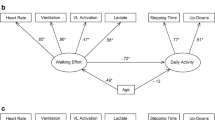Abstract
With aging, customary gait patterns change and energetic efficiency declines, but the relationship between these alterations is not well understood. If gait characteristics that develop with aging explain part of the decline in energetic efficiency that occur in most aging individuals, then efforts to modify these characteristics could delay or prevent mobility limitation. This study characterizes gait patterns in older persons with and without knee pain and tests the hypothesis that changes in gait characteristics due to knee pain are associated with increased energetic cost of walking in older adults. Study participants were 364 men and 170 women aged 60 to 96 years enrolled in the Baltimore Longitudinal Study of Aging (BLSA), of whom 86 had prevalent knee pain. Gait patterns were assessed at participant self-selected usual pace in the gait laboratory, and the energetic cost of walking was assessed by indirect calorimetry during self-selected usual pace walking over 2.5 min in a tiled corridor using a portable equipment. Participants with knee pain were less energetically efficient than those without pain (oxygen consumption 0.97 vs. 0.88 ml/(10 m · 100 kg); p = 0.002) and had slower gait speed and smaller range of motion (ROM) at the hip and knee joints (p < 0.05, for all). Slower gait speed and lower knee ROM in participants with knee pain and longer double support time and higher ankle ROM in participants without knee pain were associated with lower energetic efficiency (p < 0.05, for all). Slower gait speed and lower knee ROM were correlates of knee pain and were found to mediate the association between age and oxygen consumption. Although knee pain is associated with a higher energetic cost of walking, gait characteristics associated with energetic efficiency differ by pain status which suggests that compensatory strategies both in the presence and absence of pain may impact gait efficiency.

Similar content being viewed by others
References
Cunningham DA, Rechnitzer PA, Pearce ME, Donner AP (1982) Determinants of self-selected walking pace across ages 19 to 66. J Gerontol 37:560–564
Detrembleur C, Dierick F, Stoquart G, Chantraine F, Lejeune T (2003) Energy cost, mechanical work, and efficiency of hemiparetic walking. Gait Posture 18:47–55
Fiser WM, Hays NP, Rogers SC, Kajkenova O, Williams AE, Evans CM, Evans WJ (2010) Energetics of walking in elderly people: factors related to gait speed. J Gerontol A Biol Sci Med Sci 65:1332–1337. doi:10.1093/gerona/glq137
Inzitari M et al (2007) Gait speed predicts decline in attention and psychomotor speed in older adults: the health aging and body composition study. Neuroepidemiology 29:156–162
Kerrigan DC, Todd MK, Della Croce U, Lipsitz LA, Collins JJ (1998) Biomechanical gait alterations independent of speed in the healthy elderly: evidence for specific limiting impairments. Arch Phys Med Rehabil 79:317–322
Ko SU, Ling SM, Schreiber C, Nesbitt M, Ferrucci L (2011a) Gait patterns during different walking conditions in older adults with and without knee osteoarthritis—results from the Baltimore Longitudinal Study of Aging. Gait Posture 33:205–210. doi:10.1016/j.gaitpost.2010.11.006
Ko SU, Stenholm S, Chia CW, Simonsick EM, Ferrucci L (2011b) Gait pattern alterations in older adults associated with type 2 diabetes in the absence of peripheral neuropathy—results from the Baltimore Longitudinal Study of Aging. Gait Posture 34:548–552. doi:10.1016/j.gaitpost.2011.07.014
Ko SU, Stenholm S, Metter EJ, Ferrucci L (2012) Age-associated gait patterns and the role of lower extremity strength—results from the Baltimore Longitudinal Study of Aging. Arch Gerontol Geriatr. doi:10.1016/j.archger.2012.04.004
MacKinnon DP, Fairchild AJ, Fritz MS (2007) Mediation analysis. Annu Rev Psychol 58:593–614. doi:10.1146/annurev.psych.58.110405.085542
Mian OS, Thom JM, Ardigo LP, Narici MV, Minetti AE (2006) Metabolic cost, mechanical work, and efficiency during walking in young and older men. Acta Physiol (Oxf) 186:127–139. doi:10.1111/j.1748-1716.2006.01522.x
Richardson CA, Glynn NW, Ferrucci LG, Mackey DC (2014) Walking energetics, fatigability, and fatigue in older adults: the study of energy and aging pilot. J Gerontol A Biol Sci Med Sci. doi:10.1093/gerona/glu146
Schrack JA, Simonsick EM, Chaves PH, Ferrucci L (2012) The role of energetic cost in the age-related slowing of gait speed. J Am Geriatr Soc 60:1811–1816. doi:10.1111/j.1532-5415.2012.04153.x
Simonsick EM, Fan E, Fleg JL (2006) Estimating cardiorespiratory fitness in well-functioning older adults: treadmill validation of the long distance corridor walk. J Am Geriatr Soc 54:127–132. doi:10.1111/j.1532-5415.2005.00530.x
Acknowledgments
This research was supported entirely by the Intramural Research Program of the NIH, National Institute on Aging, and Chonnam National University. Data for these analyses were obtained from the Baltimore Longitudinal Study of Aging, a study performed by the National Institute on Aging.
Conflict of interest
All the authors declare that no financial or personal relationships were conducted with other people or organizations that could inappropriately influence or bias this work.
Author information
Authors and Affiliations
Corresponding author
About this article
Cite this article
Ko, Su., Simonsick, E.M. & Ferrucci, L. Gait energetic efficiency in older adults with and without knee pain: results from the Baltimore Longitudinal Study of Aging. AGE 37, 15 (2015). https://doi.org/10.1007/s11357-015-9754-4
Received:
Accepted:
Published:
DOI: https://doi.org/10.1007/s11357-015-9754-4




